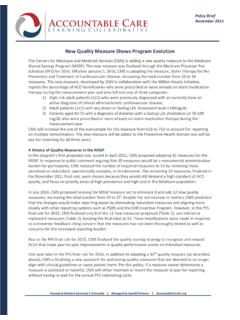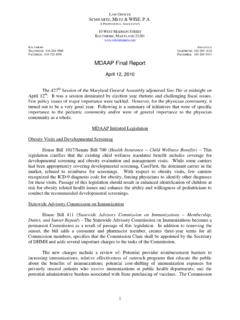Transcription of Incidental findings in Oncology
1 Incidental findings in Oncology Imaging Wan Wan Yap MBChB, FRCR, FRCPC Diagnostic Imaging , Vancouver Centre BC cancer Agency Disclosure None Outline Background Definition Current problem Specifically in Oncology imaging Vascular findings Pulmonary Embolism Organ specific Thyroid nodules Pulmonary nodules Adrenal nodules Liver lesions Adnexal lesions Background Incidentaloma ( Incidental = by coincidence; oma= tumour Greek) Unexpected , asymptomatic abnormality that are discovered serendipitously while searching for other pathology or during screening examination1. Incidental radiologic findings are common in clinical practice and research 1.
2 Managing Incidental findings on abdominal CT: white paper of the ACR Incidental findings committee. Berland LL etal J Am Coll Radiology 2010 Oct;7(10):754-73 Background Reasons for the increase Increase use of imaging from diagnosis to management Dramatic rise in cross-sectional imaging is the key reason Eg, Use of cross sectional imaging ( eg CT simulation) vs plain radiographs, CT pulmonary angiogram vs VQ scan Intravenous pyelogram vs CT urography The list goes Aging population Improve in the quality of imaging VQ scan vs CTPA VQ scan Pahade J et Radiographics 2009 Intravenous urogram CT urogram Incidental lesions in Oncology could be.
3 From the pre-existing primary primary malignancy lesion Multidiscliplinary team approach Further management depends on patient s comorbidity , performance status, life expectancy etc May impact on treatment planning eg Crohn s disease and radiation Specifically for Oncology patients Tests that are potentially problematic Screening examination CT colonography CT chest for lung screening Staging CT chest abdomen and pelvis eg. Prostate cancer Family history hereditary screening program Research CT simulation for radiation planning PET-CT What are the pros and cons?
4 Incidence of disease. Eg C T PA Incidental findings requiring follow up were nearly 3 x more common than Incidental findings change incidence of disease eg Thyroid cancer double over 30 years2,3, 61% increase in RCC. patient s anxiety for referring physicians are anxious about missing Incidental findings of recommendations for management plan for radiologists for indeterminate findings of early stage synchronous cancer 1. Hall WB, Truitt SG, Scheunemann LP, et al. The prevalence of clinically relevant Incidental findings on chest computed tomographic angiograms ordered to diagnose pulmonary embolism.
5 Arch Intern Med 2009;169: 1961-5. 2. Davies L, Welch HG. Increasing incidence of thyroid cancer in the United States 1973-2002. JAMA 2006;295:2164-7. 3. Cronan JJ. Thyroid nodules: is it time to turn off the US machines? Radiology 2008;247:602-4. Prostate cancer1 Retrospective evaluate 355 CT AP patient prostate cancer 5 year period Incidental findings (IF) are considered significant if therapeutic intervention, additional imaging or tissue sampling was advised. Rate of IF correlated to patient s age and prostate cancer risk Result: 779 IF in 292 patients were significant Synchronous malignancy in (RCC ; Lymphoma ) ALL N0M0 disease Age >65 Significant vascular findings 6 patients 1.
6 Incidental findings at initial imaging workup of patients with Prostate cancer : Clinical significance and Outcomes. Azadeh et al AJR Dec 2012 Volume 199 Number 6 Vascular findings Pulmonary embolism Pulmonary embolism Malignancy increase risks of thromboembolic disease Can be detected in CT Abdomen Pelvis ( last few slices), CT Chest ( PV phase) Central PE Generally treat What about isolated subsegmental PE (ISPE) CT AbdoPelvis ? Posterior basal RLL PE Motion artefact Non diagnostic Isolated subsegmental PE right posterobasal No PE Dedicated CT PA study Case 1: Melanoma-staging CT 26 May2016 27 May2016 CTPA study June 2nd 2016 Subsegmental PE resolved Other history: Recent craniotomy for brain mets Lung nodule Case 2: 92 man staging CT Organ specific IF Thyroid nodules Very common in adult population.
7 Large autopsy study published in 1955 found that 50% of patients with no clinical history of thyroid disease had thyroid nodules. Incidental thyroid nodules (ITN) 20-67% of ultrasound studies 25% of contrast-enhanced chest CT scans 16-18% of CT and MR of the neck 1-2% FDG PET scans What we Small thyroid cancer are indolent Incidentally detected thyroid cancer are more likely to be papillary cancer good prognosis even without treatment. Small thyroid cancers do not benefit from treatment Subclinical thyroid cancer common 36% of 101 autopsies found occult papillary cancers Davis et al reported incidence of thyroid cancer tripled from 1975-2009 but mortality stable Risk of cancer in Incidental thyroid nodules(ITN) ITN detected on US to 12%1 ITN detected on CT and MRI range from 0-11%2,3 ITN detected on FDG-PET scan at 33-35%4 1.
8 Smith-Bindman R, Lebda P, Feldstein VA, et al. Risk of thyroid cancer based on thyroid ultrasound imaging characteristics: results of a population-based study. JAMA Intern Med 2013;173:1788-96 DM, Huang T, Loevner LA, Langlotz CP. Clinical and economic impact of Incidental thyroid lesions found with CT and MR. AJNR Am J Neuroradiol 1997;18:1423-8. 13. XV, Choudhury KR, Eastwood JD, et al. Incidental thyroid nodules on CT: evaluation of 2 risk-categorization methods for workup of nodules. AJNR Am J Neuroradiol 2013;34:1812-7. KK, Bonnema SJ, Brix TH, Hegedus L. Risk of malignancy in thyroid incidentalomas detected by 18F-fluorodeoxyglucose PET: a systematic review.
9 Thyroid 2012;22:918-25 Problems Patient s anxiety Although FNABs carry minimally risk, cytology difficult to differentiate adenoma vs carcinoma repeat bx, unnecessary surgery (25-41% ITN proceed to surgery- 36-75% = benign) Only 25% of patients suspicious for malignancy Managing Incidental thyroid nodules1 ACR guidelines 3 tiered system Category 1- Any size with aggressive imaging features Category 2- <35 years old Category 3- and not meeting criteria 1 and 2 Incidental Thyroid Nodules Detected on Imaging: White Paper of the ACR Incidental Thyroid findings Committee Jenny K.
10 Hoang, MBBSa , Jill E. Langer, MDb , William D. Middleton, MDc , Carol C. Wu, MDd , Lynwood W. Hammers, DOe , John J. Cronan, MD f , Franklin N. Tessler, MD, CMg , Edward G. Grant, MDh , Lincoln L. Berland, MDg Clinical input that will be helpful : HISTORY Childhood radiation Endocrine syndromes Family history Case 1 85 year old, history of diffuse large B cell lymphoma PET-CT workup show FDG avid right thyroid nodule right thyroid nodule SUV max Hurthle cell lesion of undetermined significance Overall malignancy rate of cytology of follicular lesion of undetermined significance range from 5-30% This patient is waiting for surgery Case 2 60 female Jejunal GIST in the setting of neurofibromatosis Incidental thyroid nodule found in routine CT Benign follicular nodule with cystic degeneration Case 3 63 year old T3N2 M1 rectal cancer PET-CT FDG avid right thyroid nodule right thyroid











